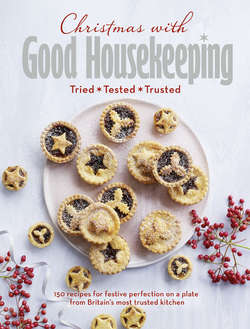Читать книгу Christmas with Good Housekeeping - Good Housekeeping - Страница 6
ОглавлениеWelcome to Christmas with
Good Housekeeping
If you absolutely love Christmas and can think of nothing better than cooking a fabulous festive lunch for family and friends, you’ve come to the right place. If, on the other hand, you’re a less confident cook but you still want to serve a sumptuous spread for your nearest and dearest, you’re also in the right place! Why? Because Good Housekeeping’s Cookery Team is dedicated to developing recipes for every kind of home cook – from the novice to the experienced and from the creative and flamboyant to the time-saving cheat!
In this very special collection of 150 Christmas recipes, there are dishes to appeal to everyone and every skill level, but they all have two major things in common – each one has been Triple-Tested by our team of expert cooks in the Good Housekeeping Institute kitchens to ensure they work every single time, nothing is left to chance, and each one is absolutely, mouthwateringly delicious. I can promise you, for instance, that the Mac ’n’ Cheese Pancetta Bites (see here) are the kind of morsels to create a lasting food memory. And even the non-vegans in my own family have been known to beg me to make our awesome Beetroot and Shallot Tarte Tatin (see here). Meanwhile, for those friends who are tricky to buy for I’ve found a bottle of home-infused Marmalade and Bay Gin (see here) goes down a storm!
After almost a century of developing Good Housekeeping recipes that are trusted by home cooks across the UK – and hungrily devoured by their families – we have honed our own skills and discovered the most flavoursome ways to entertain. Because, although the date of Christmas doesn’t change from year to year, what we want to eat does. So, before you get stuck into this collection and decide what to serve on the Big Day, the days leading up to 25 December or the days in between Christmas and New Year, I do hope you enjoy this little glimpse into the history of our kitchens.
I think we can all feel very grateful that having to use powdered eggs and dried milk is firmly a thing of the past …
1920s
Post-war housewives were no longer supported by legions of servants, and canny entrepreneurs noted this: Wonder Bread, introduced in 1925, was being sold sliced and packaged in the UK by 1930. Meanwhile, a 1926 issue of Good Housekeeping showed how to stuff and stew a calf’s heart and serve it with tomato sauce.
1930s
Kitchens with gas stoves, ice boxes and washing machines were available in the now-iconic 1930s semi, though domestic freezers were rare. A recipe in the pages of a 1935 edition of Good Housekeeping, for larded rabbit with homemade wine, set the standards of the day.
1940s
When war broke out again in 1939, food was plain and in short supply. More women had jobs for the first time, but they still had to battle with rationing. Despite powdered eggs and dried milk, Good Housekeeping recipes were always nutritious. ‘We offer no excuses for yet another article on potato dishes,’ we said as we tried to sneak potatoes into a recipe for chocolate dumplings!
1950s
Elizabeth David’s A Book of Mediterranean Food, published in 1950, tantalised with descriptions of sunshine, olive oil and apricots – yet rationing didn’t end until 1954. Good Housekeeping offered a ‘no-austerity menu’ that included cod cutlets poached in cider and served with tomatoes stuffed with peas.
1960s
Everything changed in the 1960s, including the way we ate. We drank Babycham, learned to flambé and bought fondue sets. Foreign holidays introduced us to pasta and garlic. Good Housekeeping’s April 1965 issue featured recipes for Soufflé au Liqueur and Cold Egg Mayonnaise Soufflé; a later issue suggested a cheese-tasting party.
1970s
Our enthusiasm for convenience food grew, but Delia Smith helped us perfect our moussaka and Black Forest gateau. The July 1975 pages of Good Housekeeping reflected our changing tastes, using ‘rosemary to tarragon and paprika to nutmeg, wine and vermouth’ as the ‘extra something to make chicken special’.
1980s
The 1980s was the dawn of the age of the celebrity chef and Raymond Blanc appeared on the pages of Good Housekeeping in October 1988, making the ultimate pasta dough. Fresh ready-made dishes became available and supermarkets were becoming superstores.
1990s
We became more demanding about how our food was produced, as organic food sales hit £100 million. Readers also turned to Good Housekeeping to discover how top chefs cooked, including Sally Clarke, Anton Edelmann and a young Jamie Oliver.
2000s
Online shopping really took off in the early years of the new century. It has allowed us to source with ease a new range of organic, artisan and farmhouse products. Ingredients and flavours from across the globe also became increasingly available in the early Noughties, allowing new twists on old favourites in the Good Housekeeping Institute kitchens.
Today
Never have we seen more variety than today. Yes, Christmas for many of us is still about turkey and all the trimmings, but vegetarian options are now a must in numerous households, along with fish and meat alternatives. And that’s before we even talk about pudding and that ever-popular pastime – baking!
Here’s wishing you and your loved ones a Very Happy Christmas from all of us at Good Housekeeping. May your days be merry, bright … and, most important of all, delicious!
Gaby
Huddart
Editor-in-Chief,
Good Housekeeping
